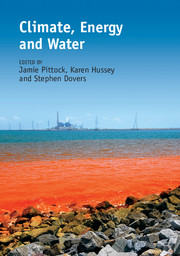Book contents
- Frontmatter
- Contents
- List of contributors
- Acknowledgements
- 1 Justifying, extending and applying “nexus” thinking in the quest for sustainable development
- 2 Water resources, climate change and energy
- 3 Implications of climate change for energy systems in a multisectoral context
- 4 Fossil fuels and water: A complex and evolving relationship
- 5 Renewable energy and water
- 6 Hydropower within the climate, energy and water nexus
- 7 Water and biofuels
- 8 Trade-offs and synergies between water and energy use in rural Australia
- 9 Management of the urban energy-water nexus
- 10 Managing the electricity-water nexus in China, France, India and the United States
- 11 Cross-sectoral governance of the climate, energy and water sectors: A ‘Rubik's cube’ analysis of cross-sectoral co-ordination
- 12 Regulation of the nexus
- 13 Climate, energy and water: the potential roles and limitations of markets
- 14 Strategies to mainstream climate change, energy, water and food security nexus knowledge and skills
- 15 A nexus of nexuses: systemic governance for climate response
- 16 Integrated modelling of the energy-water nexus in the American West
- 17 Biodiversity and the climate, energy and water nexus
- 18 Consumers, food supply chain and the nexus
- 19 Future prospects in climate, energy and water research and policy
- Index
7 - Water and biofuels
Published online by Cambridge University Press: 05 April 2015
- Frontmatter
- Contents
- List of contributors
- Acknowledgements
- 1 Justifying, extending and applying “nexus” thinking in the quest for sustainable development
- 2 Water resources, climate change and energy
- 3 Implications of climate change for energy systems in a multisectoral context
- 4 Fossil fuels and water: A complex and evolving relationship
- 5 Renewable energy and water
- 6 Hydropower within the climate, energy and water nexus
- 7 Water and biofuels
- 8 Trade-offs and synergies between water and energy use in rural Australia
- 9 Management of the urban energy-water nexus
- 10 Managing the electricity-water nexus in China, France, India and the United States
- 11 Cross-sectoral governance of the climate, energy and water sectors: A ‘Rubik's cube’ analysis of cross-sectoral co-ordination
- 12 Regulation of the nexus
- 13 Climate, energy and water: the potential roles and limitations of markets
- 14 Strategies to mainstream climate change, energy, water and food security nexus knowledge and skills
- 15 A nexus of nexuses: systemic governance for climate response
- 16 Integrated modelling of the energy-water nexus in the American West
- 17 Biodiversity and the climate, energy and water nexus
- 18 Consumers, food supply chain and the nexus
- 19 Future prospects in climate, energy and water research and policy
- Index
Summary
Introduction
The driving factor of the climate problem is the continuous increase of greenhouse gas (GHG) emissions from productive activities. Such emissions drive radiative forcing of climate and affect the radiation balance of the Earth (IPCC 2007) with global warming as a consequent effect. At a global level, GHG emissions originate from activities related to energy supply (electricity and heat generation) (41 per cent), industry (20 per cent), transport (22 per cent), residential and commercial sector (6 per cent) and 10 per cent other (forestry, agriculture, fishing, waste, etc.) (IEA 2012). The most problematic GHG, particularly due to released quantities, is carbon dioxide originated by fossil fuels combustion (60 per cent), which is mainly due to thermal and electric energy production (46 per cent) and transport (road, aviation, maritime, etc.; 23 per cent). Thus, fossil fuel is both the most widespread energy source and one of the biggest problems of modern society, due to its environmental impact and due to growing concern about the security of supply. All of these factors, together with a vision of development accompanied by energy independence, have led many countries (ie Europe, the United States, Brazil, India, China) to consider the production of energy from renewable sources, such as biomass, as an alternative to fossil fuels.
The term biomass encompasses a range of materials of heterogeneous nature with an organic matrix, able to be renewed and converted into energy. Biomass is the raw material for the production of biofuels for the transport sector, as well as of electricity and heat. In general, biomass can be considered a reservoir of solar energy captured and forfeited through the photosynthetic and metabolic processes of living organisms. Although also true for fossil fuels (coal, oil), which embed solar energy, they are relics of the geological past and cannot be renewed. In this context, energy crops should play an important role in the short-to-medium term in the replacement of fossil fuels, with global expansion of cultivated areas.
- Type
- Chapter
- Information
- Climate, Energy and Water , pp. 108 - 122Publisher: Cambridge University PressPrint publication year: 2015
- 2
- Cited by



